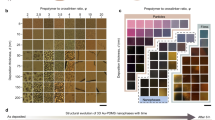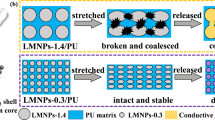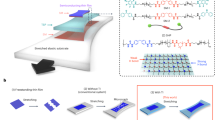Abstract
Research in stretchable conductors is fuelled by diverse technological needs. Flexible electronics, neuroprosthetic and cardiostimulating implants, soft robotics and other curvilinear systems require materials with high conductivity over a tensile strain of 100 per cent (refs 1, 2, 3). Furthermore, implantable devices or stretchable displays4 need materials with conductivities a thousand times higher while retaining a strain of 100 per cent. However, the molecular mechanisms that operate during material deformation and stiffening make stretchability and conductivity fundamentally difficult properties to combine. The macroscale stretching of solids elongates chemical bonds, leading to the reduced overlap and delocalization of electronic orbitals5. This conductivity–stretchability dilemma can be exemplified by liquid metals, in which conduction pathways are retained on large deformation but weak interatomic bonds lead to compromised strength. The best-known stretchable conductors use polymer matrices containing percolated networks of high-aspect-ratio nanometre-scale tubes or nanowires to address this dilemma to some extent6,7,8,9,10,11. Further improvements have been achieved by using fillers (the conductive component) with increased aspect ratio, of all-metallic composition12, or with specific alignment (the way the fillers are arranged in the matrix)13,14. However, the synthesis and separation of high-aspect-ratio fillers is challenging, stiffness increases with the volume content of metallic filler, and anisotropy increases with alignment15. Pre-strained substrates16,17, buckled microwires18 and three-dimensional microfluidic polymer networks19 have also been explored. Here we demonstrate stretchable conductors of polyurethane containing spherical nanoparticles deposited by either layer-by-layer assembly or vacuum-assisted flocculation. High conductivity and stretchability were observed in both composites despite the minimal aspect ratio of the nanoparticles. These materials also demonstrate the electronic tunability of mechanical properties, which arise from the dynamic self-organization of the nanoparticles under stress. A modified percolation theory incorporating the self-assembly behaviour of nanoparticles gave an excellent match with the experimental data.
This is a preview of subscription content, access via your institution
Access options
Subscribe to this journal
Receive 51 print issues and online access
$199.00 per year
only $3.90 per issue
Buy this article
- Purchase on Springer Link
- Instant access to full article PDF
Prices may be subject to local taxes which are calculated during checkout




Similar content being viewed by others
References
Rogers, J. A., Someya, T. & Huang, Y. Materials and mechanics for stretchable electronics. Science 327, 1603–1607 (2010)
Fan, Z. et al. Toward the development of printable nanowire electronics and sensors. Adv. Mater. 21, 3730–3743 (2009)
Nolfi, S. & Floreano, D. Evolutionary Robotics: the Biology, Intelligence, and Technology of Self-Organizing Machines (MIT Press, 2000)
Sekitani, T. et al. Stretchable active-matrix organic light-emitting diode display using printable elastic conductors. Nature Mater. 8, 494–499 (2009)
Torquato, S., Hyun, S. & Donev, A. Multifunctional composites: optimizing microstructures for simultaneous transport of heat and electricity. Phys. Rev. Lett. 89, 266601 (2002)
Baughman, R. H., Zakhidov, A. A. & de Heer, W. A. Carbon nanotubes—the route toward applications. Science 297, 787–792 (2002)
Lee, P. et al. Highly stretchable and highly conductive metal electrode by very long metal nanowire percolation network. Adv. Mater. 24, 3326–3332 (2012)
Hu, L. et al. Stretchable, porous, and conductive energy textiles. Nano Lett. 10, 708–714 (2010)
Chun, K.-Y. et al. Highly conductive, printable and stretchable composite films of carbon nanotubes and silver. Nature Nanotechnol. 5, 853–857 (2010)
Sekitani, T. et al. A rubberlike stretchable active matrix using elastic conductors. Science 321, 1468–1472 (2008)
Lipomi, D. J. et al. Skin-like pressure and strain sensors based on transparent elastic films of carbon nanotubes. Nature Nanotechnol. 6, 788–792 (2011)
Fuhrer, M. S. et al. Crossed nanotube junctions. Science 288, 494–497 (2000)
Zhang, Y. Y. et al. Polymer-embedded carbon nanotube ribbons for stretchable conductors. Adv. Mater. 22, 3027–3031 (2010)
Liu, K. et al. Cross-stacked superaligned carbon nanotube films for transparent and stretchable conductors. Adv. Funct. Mater. 21, 2721–2728 (2011)
Mittal, V., Kim, J. K. & Pal, K. Recent Advances in Elastomeric Nanocomposites (Advanced Structured Materials) 258 (Springer, 2013)
Yu, C. J., Masarapu, C., Rong, J. P., Wei, B. Q. & Jiang, H. Q. Stretchable supercapacitors based on buckled single-walled carbon nanotube macrofilms. Adv. Mater. 21, 4793–4797 (2009)
Xu, F., Wang, X., Zhu, Y. T. & Zhu, Y. Wavy ribbons of carbon nanotubes for stretchable conductors. Adv. Funct. Mater. 22, 1279–1283 (2012)
Kim, D. H. et al. Materials and noncoplanar mesh designs for integrated circuits with linear elastic responses to extreme mechanical deformations. Proc. Natl Acad. Sci. USA 105, 18675–18680 (2008)
Park, J. et al. Three-dimensional nanonetworks for giant stretchability in dielectrics and conductors. Nature Commun. 3 916 10.1038/ncomms1929 (2012)
Decher, G. Fuzzy nanoassemblies: toward layered polymeric multicomposites. Science 277, 1232–1237 (1997)
Mamedov, A. A. et al. Molecular design of strong single-wall carbon nanotube/polyelectrolyte multilayer composites. Nature Mater. 1, 190–194 (2002)
Hammond, P. T. Form and function in multilayer assembly: new applications at the nanoscale. Adv. Mater. 16, 1271–1293 (2004)
Schlicke, H. et al. Freestanding films of crosslinked gold nanoparticles prepared via layer-by-layer spin-coating. Nanotechnology 22, 305303 (2011)
Tang, Z. Y., Kotov, N. A., Magonov, S. & Ozturk, B. Nanostructured artificial nacre. Nature Mater. 2, 413–418 (2003)
Podsiadlo, P. et al. LBL assembled laminates with hierarchical organization from nano- to microscale: high-toughness nanomaterials and deformation imaging. ACS Nano 3, 1564–1572 (2009)
Reuter, T., Vidoni, O., Torma, V. & Schmid, G. Two-dimensional networks via quasi one-dimensional arrangements of gold clusters. Nano Lett. 2, 709–711 (2002)
Li, J. et al. Correlations between percolation threshold, dispersion state, and aspect ratio of carbon nanotubes. Adv. Funct. Mater. 17, 3207–3215 (2007)
Dirix, Y., Bastiaansen, C., Caseri, W. & Smith, P. Oriented pearl-necklace arrays of metallic nanoparticles in polymers: a new route toward polarization-dependent color filters. Adv. Mater. 11, 223–227 (1999)
Pérez-Juste, J., Rodriguez-Gonzalez, B., Mulvaney, P. & Liz-Marzan, L. M. Optical control and patterning of gold-nanorod-poly(vinyl alcohol) nanocomposite films. Adv. Funct. Mater. 15, 1065–1071 (2005)
Jin, H. J. & Weissmuller, J. A material with electrically tunable strength and flow stress. Science 332, 1179–1182 (2011)
Acknowledgements
We thank the STX foundation, Seoul, Korea, for partial funding of this research by providing a stipend to Y.K. The LBL/VAF preparation and low-temperature-conductivity studies were in part supported by the Center for Solar and Thermal Energy Conversion, an Energy Frontier Research Center (EFRC) funded by the US Department of Energy, Office of Science, Office of Basic Energy Sciences, under award number DE-SC0000957. The in-depth study of the self-assembly processes was funded by the Center for Photonic and Multiscale Nanomaterials (C-PHOM) as a part of the National Science Foundation Materials Research Science and Engineering Center programme DMR 1120923. We are also grateful to AFOSR, project FA9550-08-1-0382 and Game Changer programme for funding used for M.D.P.'s salary. The DARPA MATLOG project made possible the measurements of damping coefficients. We thank the University of Michigan’s Electron Microscopy and Analysis Laboratory (EMAL) for its assistance with electron microscopy, and for NSF grants (numbers DMR-0320740 and DMR-9871177), for funding the FEI Nova Nanolab Dualbeam Focused Ion Beam Workstation and Scanning Electron Microscope and the JEOL 2010F analytical electron microscope used in this work. We also thank EMAL and the College of Engineering for assistance with the Bruker NanoStar Small-Angle X-ray Scattering System. We also thank E. Arruda, J. Shaw and S. Daly for the use of mechanical facilities. We are grateful to Y. S. Huh for help with the high-voltage electron microscopy image.
Author information
Authors and Affiliations
Contributions
N.A.K. conceived the project. Y.K., J.Z., M.D.P. and N.A.K. designed the experiments. Y.K., J.Z. and M.D.P. performed the experiments. X.S. and C.U. measured conductivities at low temperatures. J.G.K. and S.J.Y. conducted electron microscope with high voltages. B.Y. contributed to the mechanical characterization. Y.K., J.Z., M.D.P., X.S., J.G.K., S.J.Y., B.Y., C.U. and N.A.K. analysed data. Y.K. and N.A.K. co-wrote the paper. All authors discussed the results and commented on the manuscript.
Corresponding author
Ethics declarations
Competing interests
The authors declare no competing financial interests.
Supplementary information
Supplementary Information
This file contains Supplementary Figures 1-13, Supplementary Table 1 and Supplementary References. (PDF 2599 kb)
Rights and permissions
About this article
Cite this article
Kim, Y., Zhu, J., Yeom, B. et al. Stretchable nanoparticle conductors with self-organized conductive pathways. Nature 500, 59–63 (2013). https://doi.org/10.1038/nature12401
Received:
Accepted:
Published:
Issue Date:
DOI: https://doi.org/10.1038/nature12401
This article is cited by
-
Large-area, untethered, metamorphic, and omnidirectionally stretchable multiplexing self-powered triboelectric skins
Nature Communications (2024)
-
A Generic Strategy to Create Mechanically Interlocked Nanocomposite/Hydrogel Hybrid Electrodes for Epidermal Electronics
Nano-Micro Letters (2024)
-
Structure, principle and performance of flexible conductive polymer strain sensors: a review
Journal of Materials Science: Materials in Electronics (2024)
-
A new class of transformable kirigami metamaterials for reconfigurable electromagnetic systems
Scientific Reports (2023)
-
Conductance stable and mechanically durable bi-layer EGaIn composite-coated stretchable fiber for 1D bioelectronics
Nature Communications (2023)
Comments
By submitting a comment you agree to abide by our Terms and Community Guidelines. If you find something abusive or that does not comply with our terms or guidelines please flag it as inappropriate.



